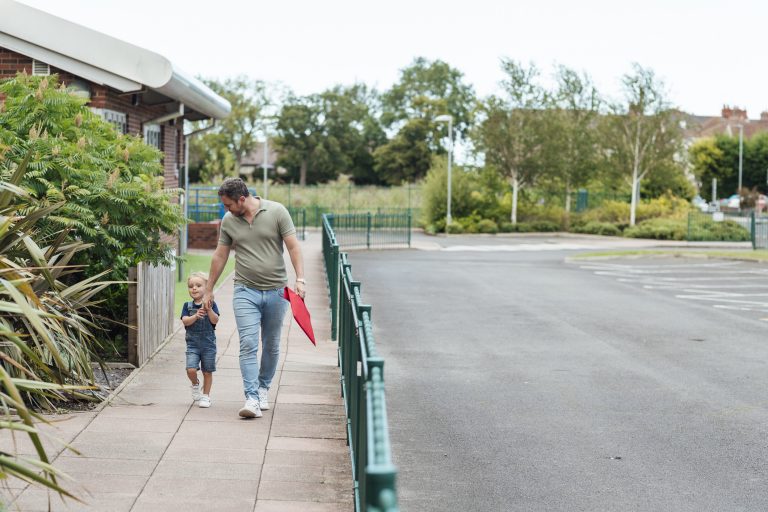The “back to school” experience will be different for everyone, but there are steps you can take to be proactive and prepared for your new school year. During this busy time, we’re giving you a head start with tips, tactics and resources to get set for the first day.
1. Start the school routine early.
It may take some significant re-structuring to get back into a regular daily routine. Start the process a couple of weeks before school resumes, so it’s not a shock to anyone’s system. You’ll want to re-establish positive habits when it comes to:
Sleep. According to the National Sleep Foundation, preschoolers (ages 3 to 5) need 10 to 13 hours of sleep every night, while school-aged kids (ages 6 to 13) should be getting 9 to 11 hours nightly. Set a consistent schedule that involves going to bed and waking up at the same time each day.
Morning routine. The chosen wake-up time should give all family members a chance to have breakfast, get dressed, brush their teeth, and fit in all of the usual morning tasks. Be sure to budget extra minutes to pack lunches (remember that?) and get yourself organized, too.
Evening activities. In the late afternoon or early evening, get everyone outside for some free time and fresh air. A predictable bedtime routine (such as a bath, followed by story time) will help younger ones wind down, while older kids’ mobile devices should be placed on their charging stations for the night.
2. Talk about what to expect.
It’s normal for kids to feel anxious about new situations, so be proactive about the transition. Start talking about school in the days leading up to it, not just the night before. Let your child ask questions, and respond honestly to his specific concerns. Previous routines may have changed dramatically due to public health protocols, so be sure to review the importance of diligent handwashing, physical distancing and mask-wearing.
Because kids may have difficulty imagining how things will look, visit the school environment in advance (if you can) to build familiarity. Walk around the schoolyard, locate the various entrances and exits, and spend some time playing on the playground or field (if permitted).
If you’re concerned that your child’s worries go beyond the typical back-to-school jitters, make arrangements to speak with a doctor, teacher, or school counselor.
3. Create a good-bye ritual.
A predictable goodbye routine helps your child know what will happen next. Brainstorm with your child to invent a distinctive parting ritual that signals that you will be leaving, and she will be starting her school day. This may involve a hug, a wave, a high-five, a special song or a rhyming phrase. Practice the ritual in advance, always reassuring your child that she will see you again later in the day. Refer to past successes where your child has spent time away from you and had a positive experience.
4. Plan social activities.
Social skills are developed when kids interact with each other, but in these times, the opportunities have been limited. Keep kids socially engaged at home by choosing activities focused on listening, interacting, and storytelling. If at-home learning has left your child feeling out of touch, pull out a past class photo to review classmates’ names and faces.
If appropriate, consider arranging an outdoor playdate with one or two peers. Create socially distant versions of familiar games (such as tag with pool noodles or soccer around pylons) to demonstrate ways of playing safely.
5. Read to your child every day.
Establishing a daily reading routine from an early age has a long list of benefits. In addition to providing one-on-one bonding time, it helps teach a key foundational skill for elementary school and beyond. Early reading experiences with parents and caregivers teach children how to speak, listen, interact, and understand the world around them. Being proficient in these areas at school will naturally boost your child’s confidence and ease his anxiety.
To set the stage, try to incorporate the back-to-school theme into reading sessions with your child. Choose books specifically about the first day of school or with storylines in a school setting.
6. Practice listening skills.
Any kindergarten teacher will confirm that listening is a critical skill for comprehension, cognitive development and overall success in school. To introduce this concept to your child, read up on what it means to be a good listener and try some listening-related activities and games.
7. Round up the gear.
Teachers will provide guidance about specific supplies, so for now, focus on the basics: a sturdy backpack, a lunch box or bag, a water bottle and a pair of indoor shoes. Do an advance inventory to see what you have on hand, and take heart in the fact that your child’s current gear may still be perfectly fine, since it didn’t necessarily get a full year of wear and tear. Involve the kids in organizing and deciding, so they can get reacquainted with their stuff. Take the time to label everything, to avoid germy mix-ups.
8. Be informed.
To prepare your kids for their school scenario, you’ll need to be up to date on what’s happening. Keep an eye on the school’s website and social media accounts for news about class placement postings, first day expectations, schedules, and possible changes to the pick-up and drop-off system. If the principal sends out a “welcome back” e-mail, read every word, and reach out with any follow-up questions. Be respectful and responsible about the health and safety measures in place, and explain them to your kids with a positive tone. Remember that things are constantly changing, so flexibility and patience will be necessary too.
By thinking ahead, you’ll be preparing your kids to cope with whatever back-to-school situation awaits them. Getting a jump on these pre-back-to-school tasks will help all of you feel organized and confident as you head into the new school year.
For more back to school posts, try these!

